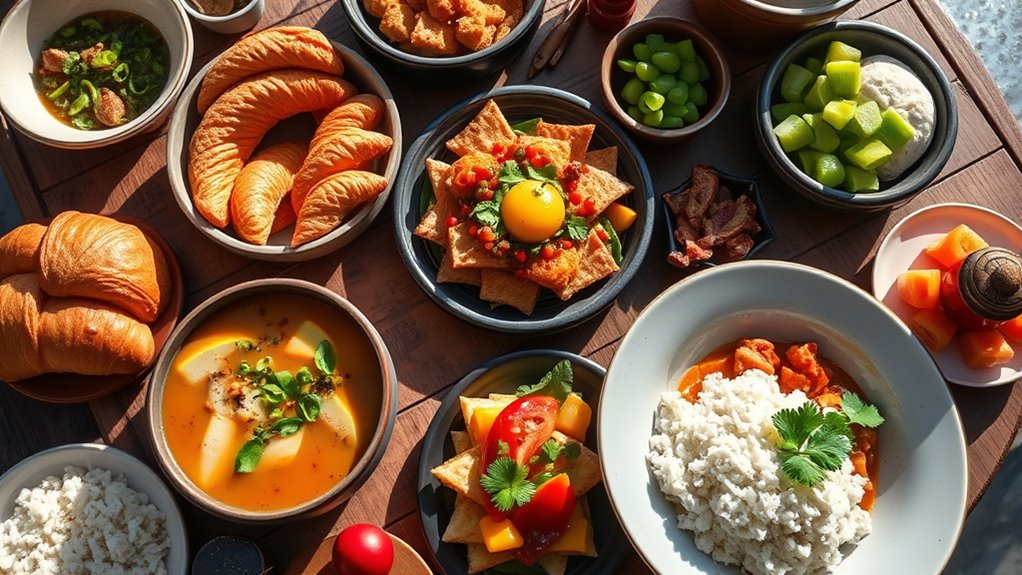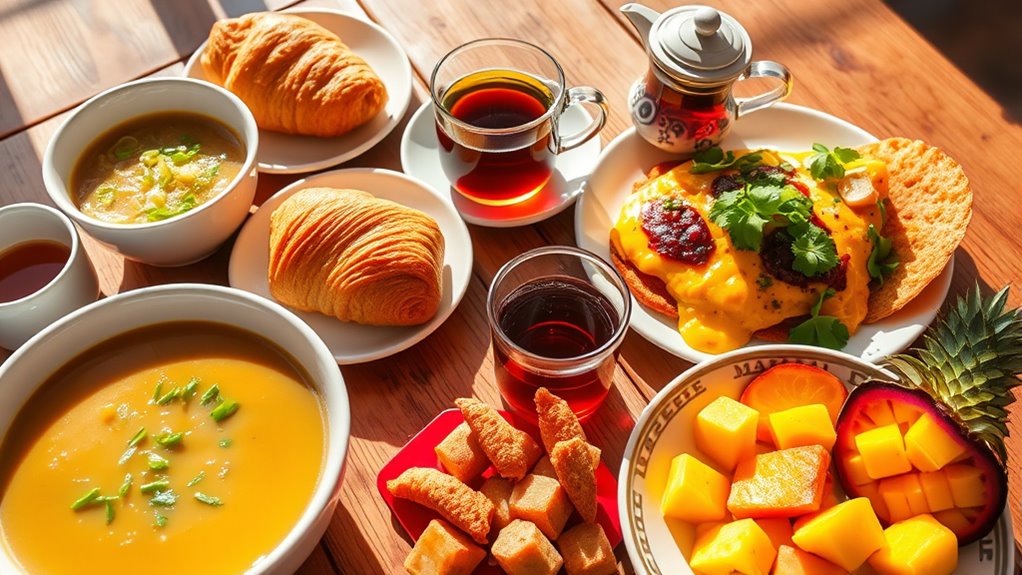Across the world, breakfast varies widely based on culture, climate, and local resources. You might find rice, miso soup, and grilled fish in Japan, while Europeans enjoy bread, cheese, or cured meats sourced nearby. In Africa, millet or tropical fruits are common, reflecting regional farms, and Scandinavians often start with smoked salmon or rye bread. The ingredients and routines reveal how environments shape daily habits—continue exploring to discover more about these delicious differences.
Key Takeaways
- Breakfast varies widely worldwide, influenced by local cultures, climates, and available ingredients.
- Regional ingredient sources, such as seafood in Japan or bread in France, shape breakfast choices.
- Climate and natural resources determine common foods, like fish in Scandinavia or tropical fruits in Latin America.
- Traditional practices and agriculture sustain regional breakfast staples like millet, maize, or rice.
- Local environments connect communities to their food, reflecting cultural identity and regional resourcefulness.

Breakfast customs vary widely around the world, offering a fascinating glimpse into different cultures and traditions. As you observe what people ate this morning, you’ll notice a rich diversity shaped by cultural variations and ingredient sources. In some places, breakfast is a quick, practical meal, while in others, it’s a leisurely social ritual. These differences aren’t just about taste; they reflect history, climate, agriculture, and local resources. For example, in Japan, breakfast might include rice, miso soup, and grilled fish, drawing from ingredient sources that are abundant in the region’s coastal environment. These ingredients are often sourced fresh daily from local markets or supplied by nearby fisheries, emphasizing the importance of regional availability and sustainability.
Across Europe, you might see a hearty breakfast of bread, cheese, and cured meats, utilizing ingredient sources that have been cultivated or preserved over generations. In France, a simple baguette with butter and jam is common, with ingredients sourced from nearby farms or bakeries that prioritize quality and tradition. Meanwhile, in Scandinavian countries, open-faced rye bread topped with smoked salmon or pickled herring highlights local preservation methods and the availability of cold-water fish. These cultural variations in breakfast items reveal how local climates and natural resources influence what’s on the table each morning.
In Africa, breakfast dishes often incorporate ingredients that are staples in the region’s diets, such as millet, sorghum, or plantains. For instance, in West Africa, you might find a bowl of porridge made from millet or maize, sourced from local farms that rely on traditional farming methods. These ingredients are often grown in the community or region, showcasing how agricultural practices and land use shape daily eating habits. Similarly, in Latin America, breakfast might include corn tortillas, beans, and tropical fruits, all of which come from regional ingredient sources that have been cultivated for centuries. These foods are deeply embedded in local traditions and agricultural cycles.
Additionally, the use of local ingredient sources ensures the freshness and sustainability of breakfast foods, reinforcing the connection between regional agriculture and cultural identity. In each case, understanding ingredient sources helps you appreciate the cultural variations that make breakfast around the world so unique. Whether it’s fish from nearby waters or grains harvested from local fields, these ingredients connect people to their environment and history. Recognizing these differences enriches your perspective, showing that breakfast isn’t just a meal; it’s a reflection of geography, culture, and resourcefulness. By exploring how ingredient sources influence what people eat in the morning, you gain a deeper appreciation for the diversity and richness of global breakfast customs.
Frequently Asked Questions
How Do Cultural Traditions Influence Breakfast Choices Worldwide?
Cultural traditions shape your breakfast choices through cultural food rituals and breakfast etiquette customs. You might prefer a hearty English breakfast, a light Japanese rice dish, or a spicy Mexican breakfast, depending on your background. These customs influence what foods you eat, how you prepare them, and when you enjoy breakfast. Your cultural identity guides your preferences, making breakfast a meaningful part of your daily routine rooted in tradition.
What Are the Healthiest International Breakfast Options?
You might think all breakfasts are the same, but the healthiest options are truly extraordinary! Opt for nutritious smoothies packed with fruits and veggies or enjoy balanced meals with whole grains, lean proteins, and fresh produce. These choices fuel your day, boost your energy, and keep you feeling great. Embracing such wholesome breakfasts worldwide can transform your mornings into powerful, health-boosting rituals for a vibrant life.
How Has Globalization Changed Traditional Breakfast Cuisines?
You’ll notice that globalization has transformed traditional breakfast cuisines by introducing fusion cuisine and breakfast fusion. You might find a Japanese-style pancake with American syrup or Indian spices mixed into European pastries. This blending of culinary traditions allows you to enjoy innovative dishes that combine flavors from around the world. It’s a dynamic way to experience breakfast, where cultural boundaries blur, creating exciting new options that reflect our interconnected food landscape.
Are There Common Ingredients Used in Breakfasts Across Different Countries?
Imagine waking up and finding breakfast staples from around the world—it’s like a global treasure hunt on your plate! You’ll notice ingredient diversity, with common staples like eggs, bread, and fruits showing up everywhere. These ingredients are so universal, they’re practically the breakfast superheroes uniting diverse cuisines. No matter where you are, these common ingredients make breakfast a delicious, worldwide celebration of flavor and tradition!
How Do Breakfast Habits Vary Between Urban and Rural Areas Globally?
You’ll notice that breakfast habits differ considerably between urban and rural areas worldwide. Urban residents often enjoy more diverse options with easier breakfast accessibility, while rural communities face dietary disparities and breakfast accessibility challenges. These differences shape what people eat, with urban areas offering convenience foods and rural areas sticking to traditional, locally available ingredients. Understanding these variations helps highlight the impact of infrastructure and resource availability on daily breakfast choices.
Conclusion
As you consider the diverse breakfasts across the globe, one thing becomes clear: our mornings reveal more than just food—they hint at stories, traditions, and secrets waiting to be uncovered. What will tomorrow’s breakfast hold? Will it bring new flavors or deep-rooted customs? The world’s breakfast table is ever-changing, and as you finish this journey, a new morning dawns with endless possibilities. The next bite might just surprise you.









